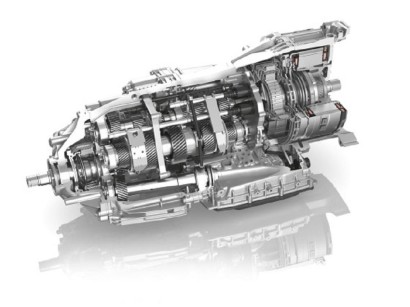- Hybrid Transmission Repair
- Hybrid Transmission Definition
- Hybrid Transmission
- Hybrid Transmission Problems
With the persistent auto-industry question of how soon battery electric vehicles will become mainstream options, Ford is preparing to widely deploy its fourth-generation hybrid-electric vehicle (HEV) technology that Dave Felipe, company vice president of powertrain engineering, said will result in a fuel-efficient, performance-rich HEV variant for “all mainstream models” in North America.
The company’s wide-ranging plan to implement hybridization is a central aspect of its commitment to invest $11 billion in new electrification technology by 2022, said Felipe, who added that the new modular hybrid technology (MHT) system for its larger and heavier vehicles that often are used for towing makes Ford “the only OEM that’s going to play in those places” with hybrid models—while market forces sort out how quickly electric vehicles are adopted for mass-market buyers.
- Hybrids also tend to use an efficient variation of the automatic transmission called a continuously variable transmission (CVT). This changes the drive ratios more steadily allowing the engine to.
- Hybrid Motor and Transmission Cutaway Step 2 - The hybrid transmission consists of gears, shafts and clutches that perform various operations such as gear selection much like a conventional transmission.
Two new HEV layouts
The fourth-generation HEV technology encompasses the new MHT layout for rear- and all-wheel-drive (AWD) models, but is designated as the fourth generation largely because of its advances in relation to previous HEVs based on front-wheel-drive platforms that began for Ford in 2005 with the Escape.
Ford’s “power-split” planetary continuously variable transmission, dubbed eCVT, is the heart of the new design and for the 2020 Escape Hybrid is paired with a significantly revised 2.5L four-cylinder running the Atkinson cycle. There also will be a plug-in hybrid-electric vehicle (PHEV) variant of the 2020 Escape that promises up to 30 miles (48 km) of battery-only driving range from its 14.4 kWh liquid-cooled lithium-ion battery pack.
For both the power-split layout and the MHT system, Ford claims significant enhancements in battery power density, system efficiency and size and mass reduction. The MHT system—based on integration of a 1.5 kWh liquid-cooled lithium-ion battery and 44-hp electric motor/generator clutched to work in cooperation with Ford’s now-familiar 10-speed automatic transmission—works in the longitudinal drivetrain layout of the company’s all-new CD6 rear-wheel-drive architecture on which the 2020 Explorer and 2020 Lincoln Aviator are based, marking the first time for a Ford rear-drive HEV application.
Hybrid Transmission Repair
Perhaps more important, the MHT is the setup Ford will use to hybridize the F-150 fullsize pickup in 2020. Felipe said it has been certified by the SAE J2807 standard to tow up to 5000 lb. (2268) kg with the Explorer Hybrid and it is conceivable the system could be tuned to provide higher towing capability for the F-150.
Ford chose a dramatic demonstration of the MHT’s performance capabilities by allowing brief drives in the 2020 Explorer Police Interceptor Hybrid, which with the direct-injection 3.3L V6 is rated at a total system output of 318 hp at 6500 rpm and 322 lb-ft (437 Nm) at 2500 rpm. Engineers said the system, which is a $3500 upcharge for the Explorer Police Interceptor, does the 0-100 mph (161 km/h) run in 17.69 s, which in testing with the Michigan State Police and Los Angeles county Sheriff’s Dept. was faster than a Dodge Durango with V8 power and only slightly slower than an Explorer Interceptor fitted with the optional turbocharged 3.0L V6.
The HF35 transmission, which incorporates two electric motors, is the first hybrid transmission to be designed and built by Ford. Previously, hybrid transmission production was handled by a.
Between improved fuel economy and the savings of running the engine much less during the long periods of idling (averaging about 60% of a typical 8-hour patrol shift, Ford’s engineers said), the Explorer Police Interceptor is expected to recoup the cost of the hybrid system in the first year of service. Projecting into the civilian 2020 Explorer Hybrid, the MHT drivetrain is estimated to deliver a combined fuel-economy rating of 24 mpg and a driving range of 500 miles (805 km) for rear-drive configurations.
Ease of fitment
Both the MHT and power-split hybrids will bring hybridization to Ford’s mainstream models by being easily integrated into their respective vehicles’ base architecture. The 2020 Escape will offer the standard power-split setup or the plug-in variant simply by changing batteries, either of which is integrated under the floor, meaning no compromise for interior packaging. The 198-hp Escape Hybrid with AWD employs the same mechanical propshaft setup as the IC-only Escape with AWD; for now, the 209-hp PHEV Escape is front-drive only.
Hybrid Transmission Definition
Engineers said the 2020 Escape Hybrid is 20% more efficient than its predecessor, with a big gain in power-electronics efficiency and for the twin motors, while being 20% faster and 50% more fuel-efficient than the current 1.5L Escape. Ford has yet to reveal official fuel-economy figures for the Escape Hybrid and the Escape PHEV, but highway fuel economy could approach 40 mpg for the Escape Hybrid.


Should Ford decide in the future to fit an electrically-driven rear axle for AWD models, “we have the technology in house,” said one engineer, but for now, it appears using the conventional AWD design is from a manufacturing standpoint an effective approach, not to mention a lighter one. The new Escape is some 200 lb. (91 kg) lighter than the current model and incorporating an e-axle at the rear would add as much as 40 lb. (18 kg).
Hybrid Transmission
For the MHT, it has 90% parts commonality with the conventional 10R automatic transmission and is only marginally longer overall, meaning it can go down the same manufacturing line as the conventional transmission, while the MHT’s extra overall length can be easily accounted for by altering driveshaft length.
Hybrid Transmission Problems
Continue reading »